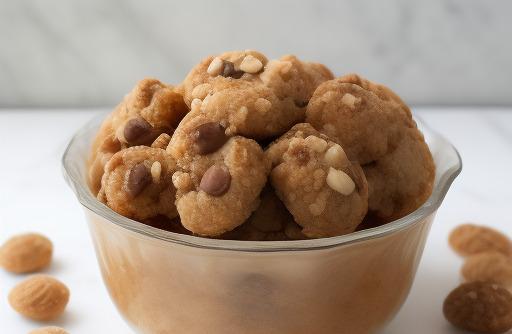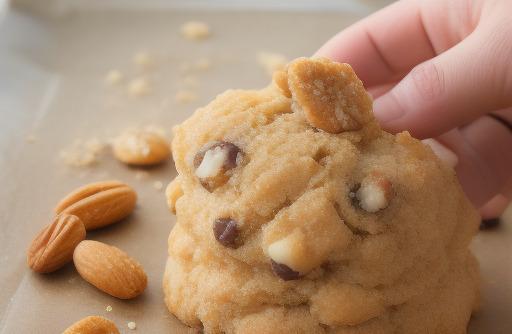- You are here:
- Home »
- Food Substitutes
- » Best Substitutes For Nuts In Baking
Best Substitutes For Nuts In Baking

Nuts are a common ingredient in baking, adding texture, flavor, and nutritional value to a wide range of baked goods. However, allergies, dietary restrictions, and personal preferences may require you to find alternatives to nuts in your recipes. Luckily, there are several substitutes available that can mimic the taste and texture of nuts, making it possible to create delicious baked goods without compromising on flavor or quality. In this article, we will explore the best substitutes for nuts in baking and provide tips on how to use them effectively.
Key Takeaways
- Nuts are a versatile ingredient in baking but may need to be replaced due to allergies, dietary restrictions, or personal preferences.
- There are several substitutes for nuts in baking, including seeds, oats, coconut, and dried fruits.
- The choice of substitute depends on the recipe and desired flavor and texture.
- Substitute measurements may vary, and it is essential to adjust accordingly to maintain the balance of the recipe.
- Experimenting with different substitutes can also lead to unique flavors and textures in your baked goods.
Why You Need A Substitute For Nuts In Baking
There are several reasons why you may need to find a substitute for nuts in your baking recipes. The most common reasons include allergies, dietary restrictions, and personal preferences.
Allergies: Nut allergies are one of the most prevalent food allergies, and they can range from mild to severe. For those with nut allergies, even a small trace of nuts can trigger an allergic reaction. Therefore, finding a suitable substitute is crucial for individuals with nut allergies.
Dietary Restrictions: Some individuals follow specific dietary plans that eliminate nuts. For example, people following a low-carb, grain-free, or paleo diet may need to avoid nuts due to their higher carbohydrate and phytic acid content. In these cases, finding alternative ingredients becomes necessary to adhere to the dietary restrictions.
Personal Preferences: Not everyone enjoys the taste or texture of nuts in baked goods. Some individuals may find nuts too crunchy or overpowering in flavor. Additionally, nuts can be expensive, making them less accessible to certain individuals. In such cases, exploring alternative ingredients can enhance the overall baking experience for those with personal preferences.
Types Of Substitutes For Nuts In Baking

When it comes to substituting nuts in baking, several options can provide similar texture, flavor, and nutritional value. The choice of substitute depends on the specific recipe and the desired outcome. Here are some common substitutes for nuts in baking:
-
Seeds: Seeds such as sunflower seeds, pumpkin seeds, and sesame seeds can be excellent replacements for nuts. They offer a similar crunch and texture while adding a subtle nutty flavor to the baked goods. Seeds are also rich in healthy fats, protein, and essential minerals.
-
Oats: Rolled oats or oatmeal can add a lovely texture to baked goods, mimicking the crunch of nuts. They provide a slightly nutty flavor and are an excellent option for those with gluten allergies or sensitivities.
-
Coconut: Desiccated coconut or shredded coconut can be used as a nut substitute, especially in recipes that call for shredded nuts. Coconut adds a delicate sweetness and texture to the baked goods. It is rich in fiber and also provides healthy fats.
-
Dried Fruits: Dried fruits like raisins, apricots, cranberries, or cherries can provide a chewy texture and burst of sweetness in baked goods. They can be chopped or used as whole pieces, replacing nuts effectively.
-
Cereal: Certain types of cereals, like Rice Krispies or corn flakes, can be crushed and used as a nut substitute. Cereal adds crispiness to baked goods and can be an excellent choice for cookies, bars, or granola recipes.
Best Substitutes For Nuts In Baking
Now that we have discussed the various types of substitutes for nuts in baking let’s explore some of the best options available in more detail:
-
Sunflower Seeds: Sunflower seeds are an excellent substitute for nuts, offering a similar taste and texture. They have a mild nutty flavor and can be used whole or ground in baking recipes. Sunflower seeds are a rich source of vitamin E, healthy fats, and minerals like magnesium and selenium. They work well in cookies, bread, muffins, and granola bars.
-
Pumpkin Seeds: Pumpkin seeds, also known as pepitas, are another fantastic alternative to nuts. These green seeds have a slightly sweet and nutty flavor. They can be used whole or ground in recipes like bread, muffins, and energy balls. Pumpkin seeds are a great source of protein, healthy fats, fiber, and micronutrients like iron and zinc.
-
Sesame Seeds: Sesame seeds have a distinct nutty flavor and can be used as a substitute for nuts in baking. These small seeds work well in cookies, bread, and savory baked goods like crackers. They are rich in healthy fats, protein, and minerals like calcium, magnesium, and iron.
-
Rolled Oats: Rolled oats are a versatile substitute for nuts, adding a pleasant chewiness and texture to baked goods. They are commonly found in muffins, cookies, and granola bars. Oats are high in fiber, protein, and essential vitamins and minerals. They can be used as whole oats or ground into flour for baking.
-
Desiccated Coconut: Desiccated coconut is made from dried coconut meat and can be used in place of nuts in various baking recipes. It adds a lovely sweetness and texture to cookies, cakes, and bread. Coconut is also an excellent source of fiber, healthy fats, and essential minerals.
-
Raisins: Raisins are dried grapes that can be a flavorful substitute for nuts in certain recipes, especially cookies and bars. They provide a natural sweetness and a soft, chewy texture. Raisins are rich in antioxidants, fiber, and iron.
-
Dried Cranberries: Dried cranberries offer a tart and sweet flavor that can replace nuts in recipes like muffins, bread, and cookies. They add a pop of color and a burst of flavor. Dried cranberries are a good source of vitamins, minerals, and antioxidants.
-
Cereal: Certain types of cereal, like Rice Krispies or corn flakes, can be crushed and used as a nut substitute in recipes like cookies, bars, and granola. They provide a crispy texture and can add a touch of sweetness. Cereal is often fortified with essential vitamins and minerals, making it a nutritious option.
These substitutes can be used interchangeably or combined in different ratios to create unique flavors and textures in your baked goods. Experimenting with various combinations can lead to exciting new recipes and flavors.
Choosing The Right Substitute For Nuts In Baking

While all the substitutes mentioned above can work well in baking, it is essential to choose the right one depending on the recipe and desired outcome. Here are a few factors to consider when selecting a nut substitute:
1. Flavor: Consider the flavor profile of the recipe. If the nutty flavor is essential, choose a substitute that provides a similar taste. For example, sunflower seeds or sesame seeds can mimic the nuttiness of almonds or walnuts, while coconut adds a subtle sweetness.
2. Texture: Think about the texture that nuts contribute to the recipe. For a crunchy texture, seeds or oats can be ideal substitutes, whereas dried fruits like raisins or cranberries will add a chewy texture.
3. Allergies or Dietary Restrictions: If you are avoiding nuts due to allergies or dietary restrictions, ensure that the chosen substitute aligns with your specific dietary needs. For example, if you are following a low-carb diet, choosing seeds or coconut may be more suitable than oats or dried fruits.
4. Nutritional Content: Consider the nutritional value of the substitute. Seeds, oats, and coconut are all nutrient-dense alternatives. For example, seeds provide healthy fats, minerals, and protein, while oats offer fiber, vitamins, and minerals.
By considering these factors, you can select the right substitute that meets your specific needs and enhances your baking experience.
Cooking With Substitutes For Nuts In Baking
When using substitutes for nuts in baking, it is essential to make a few adjustments to ensure that the recipe turns out delicious and well-balanced. Here are some tips to keep in mind when cooking with nut substitutes:
- Measurements: The measurement of the substitute may differ from the original amount of nuts mentioned in the recipe. For example, if a recipe calls for one cup of chopped nuts, you may need to use 3/4 cup of the substitute to achieve a similar bulk and texture. Start by using less than the recommended amount and adjust as needed after tasting and assessing the texture of the batter or dough.
Pro Tip: It is always a good idea to keep a journal or make notes when experimenting with substitutes. This way, you can record the adjustments you made and refer to them in the future to replicate successful substitutions.
-
Texture: Pay attention to the texture of the substitute you are using. If you want a crunchy texture, sunflower seeds or crushed cereal can be more suitable. On the other hand, oats or dried fruits like raisins can add a chewy texture. Adjust the cooking time accordingly to ensure the desired texture is achieved.
-
Flavor: Consider the flavor profile of the substitute you are using. Some substitutes add a distinct flavor to the baked goods, while others are more subtle. Taste the batter or dough before baking to ensure the flavor is balanced. If necessary, adjust the sweetness or add additional flavorings like vanilla extract or spices to enhance the overall taste.
-
Nutrient Content: Take advantage of the nutritional benefits offered by the substitutes. For example, if you are using seeds or coconut as a nut substitute, you are adding healthy fats, protein, and minerals to your baked goods. Use this opportunity to create nutritious and wholesome treats.
Remember that using substitutes for nuts may not produce the exact same result as using the original ingredient, but it can still lead to delicious and satisfying baked goods. Embrace the variety and uniqueness that the substitutes bring to your recipes.
Recipes Using Substitutes For Nuts In Baking

To give you some inspiration, here are a few recipes that use substitutes for nuts in baking:
1. Sunflower Seed Chocolate Chip Cookies
Ingredients:
- 1 cup all-purpose flour
- 1/2 teaspoon baking soda
- 1/4 teaspoon salt
- 1/2 cup unsalted butter, softened
- 1/2 cup granulated sugar
- 1/2 cup brown sugar
- 1 large egg
- 1 teaspoon vanilla extract
- 3/4 cup chocolate chips
- 3/4 cup sunflower seeds
Instructions:
- Preheat the oven to 350°F (175°C) and line a baking sheet with parchment paper.
- In a medium bowl, whisk together the flour, baking soda, and salt.
- In a separate large bowl, cream together the butter, granulated sugar, and brown sugar until light and fluffy.
- Beat in the egg and vanilla extract until well combined.
- Gradually add the dry ingredients to the wet ingredients, mixing well after each addition.
- Fold in the chocolate chips and sunflower seeds.
- Drop rounded tablespoons of dough onto the prepared baking sheet, spacing them about 2 inches apart.
- Bake for 10-12 minutes or until the edges turn golden brown.
- Allow the cookies to cool on the baking sheet for a few minutes before transferring them to a wire rack to cool completely.
2. Coconut Banana Bread
Ingredients:
- 2 cups all-purpose flour
- 1 teaspoon baking soda
- 1/2 teaspoon salt
- 1/2 cup unsalted butter, softened
- 1 cup granulated sugar
- 2 large eggs
- 1 teaspoon vanilla extract
- 3 ripe bananas, mashed
- 1/2 cup desiccated coconut
- 1/2 cup raisins
Instructions:
- Preheat the oven to 350°F (175°C) and grease a 9×5-inch loaf pan.
- In a medium bowl, whisk together the flour, baking soda, and salt.
- In a separate large bowl, cream together the butter and sugar until light and fluffy.
- Beat in the eggs, one at a time, followed by the vanilla extract.
- Gradually add the mashed bananas to the wet ingredients, mixing well after each addition.
- Stir in the dry ingredients until just combined.
- Fold in the desiccated coconut and raisins.
- Pour the batter into the prepared loaf pan and smooth the top with a spatula.
- Bake for 55-60 minutes or until a toothpick inserted into the center comes out clean.
- Allow the banana bread to cool in the pan for 10 minutes before transferring it to a wire rack to cool completely.
Storage And Shelf Life Of Substitutes
When using substitutes for nuts in baking, it is important to consider their storage and shelf life. Here are some guidelines:
- Seeds: Store seeds in an airtight container in a cool, dark place. They can be refrigerated to extend their shelf life. Most seeds, such as sunflower seeds and pumpkin seeds, can last for several months when stored properly.
- Oats: Rolled oats and oatmeal should be stored in an airtight container in a cool, dry place. Properly stored oats can last up to one year.
- Coconut: Desiccated coconut should be stored in an airtight container in a cool, dry place. It can last for several months. Shredded coconut may have a shorter shelf life and should be used within a few weeks or refrigerated for longer storage.
- Dried Fruits: Dried fruits should be stored in airtight containers in a cool, dry place. They can last for several months but may harden over time. If the dried fruits become too hard, they can be soaked in warm water to soften before use.
- Cereal: Crispy cereals should be stored in airtight containers in a cool, dry place. They can last for several months if kept away from moisture.
It is always a good practice to check for signs of spoilage, such as a rancid smell or mold, before using any substitute in baking. If the substitute shows any signs of deterioration, it is best to discard it and use a fresh batch.
Conclusion
Finding substitutes for nuts in baking is not only possible but also opens up new opportunities for unique flavors and textures in your baked goods. Whether you are dealing with allergies, dietary restrictions, or personal preferences, there are several options to choose from, including seeds, oats, coconut, and dried fruits. These substitutes can be used interchangeably or in combination to mimic the taste, texture, and nutritional value of nuts. By choosing the right substitute, adjusting the measurements, and considering factors like flavor and texture, you can create delicious baked goods without compromising on quality. So go ahead and explore the world of nut-free baking while still enjoying the satisfaction of homemade treats.
FAQS
What Are Some Good Nut Substitutes For Baking?
Sunflower seeds, pumpkin seeds, chia seeds, flax seeds, and hemp seeds are all great nut substitutes for baking. They are full of healthy fats, protein, and fiber, and they can add great texture and flavor to your baked goods.
Can I Use Seeds As A 1:1 Replacement For Nuts In Recipes?
It’s important to note that seeds and nuts have different textures, flavors, and nutritional profiles, so you may need to adjust the amount and type of seed you use in a recipe. Try to find recipes that have already been tested with your chosen substitute, or experiment with small batches to find the right balance.
What About Using Coconut As A Nut Substitute?
While coconut is a popular ingredient in many baked goods, it is not technically a nut and can be a great alternative for people with nut allergies. However, since coconut has a strong flavor and high fat content, it may not work as a substitute in every recipe. Consider using coconut flour or coconut flakes instead of chopped nuts.
Are There Any Other Plant-based Alternatives To Nuts For Baking?
Yes, there are many other ingredients that can add texture and flavor to your baked goods, such as shredded carrots or zucchini, raisins, cranberries, chocolate chips, or even popcorn. These ingredients can provide a similar crunch or chewiness to nuts without the risk of allergens.
How Do I Substitute Seeds For Nut Butter In Recipes?
Nut butter can be a delicious and nutritious addition to baked goods, but it can also be high in calories and expensive. Seed butter, such as sunflower seed butter or tahini, can be a great alternative. To substitute seed butter for nut butter, use a 1:1 ratio and adjust the amount of sugar and liquid in the recipe if needed.
Sources
About the Author Jenny
I'm Jenny, a housewife with an unwavering passion for food. My culinary journey began with my grandmother's kitchen, and it's now a full-fledged food blog. I've turned my love for cooking into a creative outlet, sharing recipes and stories with a global community of fellow food enthusiasts. It's proof that being a housewife can also mean pursuing your passions and savoring life's delectable moments.
